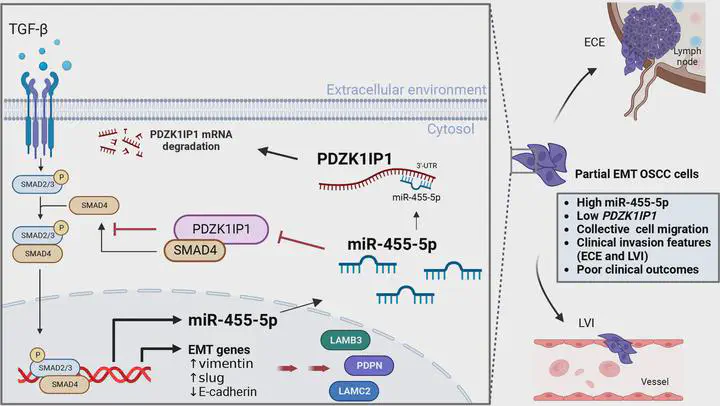MiR-455-5p suppresses PDZK1IP1 to promote the motility of oral squamous cell carcinoma and accelerate clinical cancer invasion by regulating partial epithelial-to-mesenchymal transition

Abstract
Background:
Lymph node and distant metastasis contribute to poor outcomes in patients with oral squamous cell carcinoma (OSCC). The mechanisms regulating cancer migration and invasion play a key role in OSCC.
Methods:
We determined migration and invasion ability of OSCC by wound-healing assay, two-chamber transwell invasion assay and cell mobility tracking and evaluated tumor metastasis in vivo. Western blot (WB), qRT-PCR, RNA-seq, dual-luciferase reporter assays and nuclear/cytoplasmic fractionation were performed to investigate the potential mechanism. Immunohistochimical (IHC) staining determined vimentin and PDZK1IP1 expression in OSCC tissues.
Results and conclusions:
In this study, we determined that miR-455-5p was associated with lymph node metastasis and clinical invasion, leading to poor outcomes in patients with OSCC. MiR-455-5p promoted oral cancer cell migration and invasion and induced epithelial-to-mesenchymal transition (EMT). We also identified a new biomarker, PDZK1IP1 (MAP17), that was targeted by miR-455-5p. PDZK1IP1 knockdown led to migration, metastasis, EMT, and increased transforming growth factor-β signaling in OSCC. In addition, miR-455-5p overexpression and PDZK1IP1 inhibition promoted collective OSCC cell migration. According to data from the Cancer Genome Atlas database and the NCKU-OrCA-40TN data set, miR-455-5p and PDZK1IP1 are positively and negatively correlated, respectively, with partial EMT score. High miR-455-5p expression was associated with high vimentin levels and low MAP17 H-scores. The patients with low MAP17 expression had higher rates of disease recurrence than did patients with high MAP17 expression, especially for patients with clinical invasion risk factors and low MAP17 expression. These results suggest that miR-455-5p suppresses PDZK1IP1 expression and mediates OSCC progression. MiR-455-5p and PDZK1IP1 may therefore serve as key biomarkers and be involved in regulating partial EMT in OSCC cells. PDZK1IP1 expression may also serve as an independent factor that impacts outcomes in patients with clinical risk factors for recurrence.